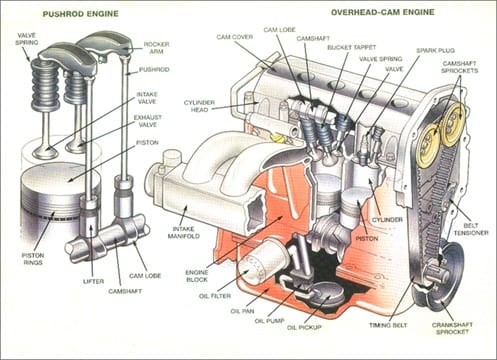Just like the human body relies on various organs to function, a car engine is a complex system composed of numerous parts working in harmony to power your vehicle. At its core, the engine transforms fuel energy into mechanical motion through a process of internal combustion – essentially, controlled mini-explosions that generate power. While often perceived as a single unit, the engine is actually an assembly of individual components, each playing a vital role. Understanding the names and functions of these parts is crucial for any car owner seeking to grasp the basics of automotive mechanics and ensure proper vehicle maintenance.
Essential Components of Your Car Engine
 Diagram of Car Engine Parts – Engine Block, Pistons, Crankshaft, Camshaft, Cylinder Head, Timing Belt
Diagram of Car Engine Parts – Engine Block, Pistons, Crankshaft, Camshaft, Cylinder Head, Timing Belt
Car engines are built around robust, sealed metal structures known as cylinders. Modern cars typically house between four and eight cylinders, although some high-performance vehicles can boast up to twelve or even sixteen. These cylinders are meticulously designed to open and close at precise intervals, allowing fuel to enter for combustion and exhaust gases to escape. Let’s delve into some of the most critical car engine parts and explore their functions, referencing the diagram for visual context.
Engine Block: The Foundation
The engine block serves as the central framework of the engine. Usually constructed from aluminum or iron, it is engineered with multiple cylindrical cavities to accommodate the cylinders. Furthermore, it incorporates intricate channels for the circulation of coolant and oil, vital for engine temperature regulation and lubrication. Coolant passages are broader than oil passages to facilitate efficient heat dissipation. The engine block is also the housing for key components such as the pistons, crankshaft, and camshaft, and can contain anywhere from four to sixteen cylinders arranged in configurations like inline, flat, or V-shaped, depending on the vehicle’s design.
Pistons: Converting Combustion into Motion
Pistons are cylindrical components featuring a flat top surface. Their primary function is to convert the energy released during combustion into mechanical force, which is then transmitted to the crankshaft to propel the vehicle. Within each cylinder, a piston moves up and down twice for every crankshaft rotation. In engines operating at 1250 RPM, a piston will complete 2500 up-and-down cycles per minute. Piston rings, located within grooves on the piston’s circumference, play a crucial role in maintaining cylinder compression and minimizing friction from the piston’s constant contact with the cylinder walls.
Crankshaft: Transforming Linear to Rotational Motion
Positioned in the lower section of the engine block within crankshaft journals (bearing surfaces), the crankshaft is a precisely machined and balanced component. It connects to the pistons via connecting rods. Resembling a jack-in-the-box mechanism, the crankshaft converts the pistons’ vertical reciprocating motion into rotational motion at engine speed. This rotational force is ultimately what drives the vehicle’s wheels.
Camshaft: Orchestrating Valve Timing
The camshaft’s location varies depending on the vehicle model, residing either within the engine block or in the cylinder heads. Many contemporary vehicles employ cylinder head placement, often utilizing Dual Overhead Camshaft (DOHC) or Single Overhead Camshaft (SOHC) configurations. Supported by a series of oil-lubricated bearings for enhanced durability, the camshaft’s role is to regulate the timing of valve opening and closing. It transforms the crankshaft’s rotary motion into an up-and-down motion to control lifters, which in turn actuate pushrods, rockers, and valves. This precise timing is essential for the engine’s intake and exhaust cycles.
Cylinder Head: Housing Valves and Passageways
Attached to the engine block with cylinder bolts and sealed by the head gasket, the cylinder head is a complex component. It houses numerous parts, including valve springs, valves, lifters, pushrods, rockers, and camshafts. Crucially, the cylinder head contains intake and exhaust passages. Intake passages facilitate the flow of air into the cylinders during the intake stroke, while exhaust passages enable the expulsion of combustion gases during the exhaust stroke.
Timing Belt/Chain: Synchronization for Engine Operation
The camshaft and crankshaft must be synchronized to ensure accurate valve and piston timing, which is vital for proper engine function. This synchronization is achieved through either a timing belt or a timing chain. A timing belt is constructed from durable rubber reinforced with cogs that mesh with pulleys on the camshaft and crankshaft. A timing chain, similar to a bicycle chain, wraps around toothed pulleys, providing a more robust and often longer-lasting synchronization solution.
Recognizing Common Engine Issues
Given the intricate nature of the engine and the high speeds at which its components operate, wear and tear over time are inevitable. This wear can lead to various engine problems, manifesting in changes in your car’s performance. Here are some prevalent engine problems and their associated symptoms:
- Poor Compression: Can result in reduced engine power, engine misfires, or the inability to start the engine.
- Cracked Engine Block: May cause engine overheating, smoke emanating from the exhaust, or coolant leaks, often visible on the engine’s exterior.
- Damaged Pistons, Rings, and/or Cylinders: Can exhibit symptoms such as rattling noises, blue-tinted smoke from the exhaust, rough engine idling, or failure to pass emissions tests.
- Broken or Worn Rods, Bearings, & Pins: May produce tapping or ticking sounds, low engine oil pressure, metallic particles in the engine oil, or rattling sounds during acceleration.
While car engines may appear intricate, their fundamental purpose is straightforward: to propel your vehicle forward. With numerous components working in concert to generate this motion, regular vehicle maintenance is paramount to ensuring their longevity. Routine oil changes, fluid flushes, and timely replacement of belts and hoses are essential preventative measures that can significantly reduce the risk of engine failure. Understanding the Parts To A Car Engine is the first step in appreciating the complexity and the importance of caring for this vital system.